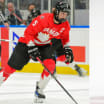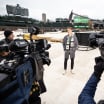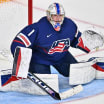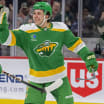NHL.com's Q&A feature called "Five Questions With…" runs every Tuesday. We talk to key figures in the game and ask them questions to gain insight into their careers and the latest news.
The latest edition features Barbara Underhill, skating development consultant for the Toronto Maple Leafs and Tampa Bay Lightning.
Five Questions with Barbara Underhill
Skating consultant discusses role with NHL players, Gender Equality Month
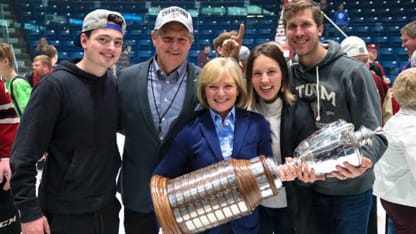
Barbara Underhill was open to the idea immediately.
A former world and Canadian national champion in pairs figure skating, Underhill hadn't thought about getting involved in hockey outside of taking her sons to the rink for their games. But in 2006, the coach of Guelph of the Ontario Hockey League (Underhill and her husband Rick Gaetz are part owners) asked if she would like to help improve Guelph players skating.
"I really missed skating, so I said, 'Yeah, I'll give it a try,'" said Underhill, who had been a skating commentator on television for 16 years before she was approached for this opportunity.
"I didn't really know what I was getting into. I just remember getting on the ice in Guelph and just having this crazy feeling like I knew this was where I needed to be and where I needed to go. It just felt so good to be on the ice again. I had been on it my entire life. Being back on the ice was like, I felt I came alive again. So I made a decision at that point to leave broadcasting and take this up full time."
Here are Five Questions with… Barbara Underhill.
How did those first sessions go and when did the NHL come calling?
"I jumped into it [in 2006] and started working with several of the players on the Guelph team. My focus was really just helping them and also trying to really figure out the science of it. It's obviously very different on a figure skating blade than on a hockey blade. Playing a game is different than figure skating. There was a lot to figure out, and I sort of immersed myself, became obsessed with trying to figure it all out.
"Within about a year, I was getting calls from NHL teams. I guess they had seen players I was working with, seeing the results I was getting. I think my timing was really good, too. I got in at a time when skating was becoming more and more critical in hockey, it was becoming one of the most important things. But the funny thing was, (I) never said, 'I want to be an NHL skating coach.' I never said that. It just all evolved. When you love something, and you just do it out of passion, doors just start to open."
How did you develop a program that worked for you?
"It was trial and error. One day I came home, my husband had been in a golf tournament and he had a video showing his swing compared with Tiger Woods. I could see what he was doing wrong. I'll never forget that because it sparked something in me and I just said, 'Oh, I could do this in hockey.' This was before iPads and things like that, so I had to get this big video camera and I said, 'I can do comparisons with players, but I've got to find my Tiger Woods.' I knew at the time that [former NHL forward] Mike Gartner was known as one of the best skaters in hockey, he had won the [1996 NHL] All-Star skating contest. I called and asked him if we could videotape his skating, so that's what I did. I studied how he moved, it was so efficient and effortless, so perfect, everything symmetrical. So I studied it and then I got some software that would allow me to upload players skating, film at exact same angle and put them side by side. I could show a player and say, 'Look, here's Gartner, here's you. Look at how his knees are driving under his hips, yours are coming out.' That was the biggest thing because, not only was I able to learn from it, the players were able to see it and most of them are so visual. When they can see it, they can do it and understand it better.
"My technique has evolved over 10 years, and I keep learning every day. I do things way different than back then, because I'm learning from players every day. I want to continue to learn and be better, find different ways, find better ways and think outside the box. Every player, for me, is like a puzzle. I just like figuring everything out, where the blocks are. When you move, everything needs to flow, every joint needs to move. If one is stuck, like your shoulder, it throws everything out of whack. So, we work on getting everything in synch, symmetrical and working like a machine. When I watch a player, I can see what's out of synch and what needs to be done."

What's it like to see these players putting your lessons to work?
"It's the best part about my job. when you see a player improve, when you see a player reach that next step, when you see a player play his first NHL game and texts you after and thanks you, I'm just one small piece of the puzzle. There are so many other people; there's a whole village there trying to get to the next level. But it's rewarding especially because I spent so much time with these guys 1-on-1. A lot of times I spend time with players coming back from injuries. I see players when they're at a very vulnerable state. I really get to know the player and I think it's the best feeling when you see a player reach that next level, knowing you played a small role. When I think of my career in figure skating, I think of the number of people that it took for us to get there, you know? It's crazy when you think of the people who are supporting you and that it requires to get there. I was fortunate to have such a great support team and it's just cool now that I'm on the other side. Once in a while, you see a kid's dream come true and it's awesome."
How many players do you work with and how long are sessions?
"There aren't really any numbers [with players]. There's a lot; sometimes too many. It's a shame, because I want to help everyone. But you can only be on the ice so many hours a day. What I do is very physical. I don't want to stand around or on the side and watch. I need to participate, I need to be really physically involved, and that's what I love so much, the fact that I can still fly around and skate, that's my life. It's pretty cool I still get to do what I love. Very cool, so the physical part of it is what I love so much and when I get to that point, when I physically can't do it anymore, I don't know, I'll evolve into another role. That'll be hard for me. So I try to keep myself in as good a shape as possible to do what I do.
"[Session time] differs, but generally I work with a player for 45 minutes to an hour in the offseason. During the season, especially if you're playing games, I'll probably schedule less time, probably 25 minutes or a half hour. I work for Tampa as well as Toronto, so I make trips to Syracuse, [the Lightning's] farm team, and to Tampa as well. There's the odd time I'll go out and visit a prospect, but a large amount of my time is in Toronto."
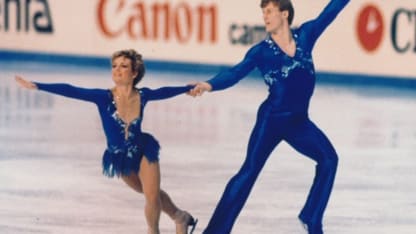
This is the final day of celebrating Gender Equality Month. What does it mean to you?
"When I got into hockey, there was never a thought or even a dream, I never said, I want to be a skating coach in the NHL. It really wasn't a gender thing. When I made it, it was an expertise thing; I had an expertise that they needed. For me, it never occurred to me that there was a barrier there. I've never looked at barriers at all in my life. Perhaps I have to thank my parents; I have to thank my sport, because I just went after whatever I wanted to go after. I think the other thing is, I learned early on that failure is a positive thing. I didn't have a fear of it because I failed so many times already in my skating career that I knew there's always something to come from it. I can recall walking into this board room full of men, GMs and high-level hockey guys and I just walked in and showed them what I could do. There was no feeling that I was out of place, because I knew I had the expertise that they wanted. If you're confident in what you do, there's no gender barriers. Just do what you do.
"Having said that, things have changed dramatically since I've been in the NHL. Now when I walk into the rink, there's a handful of women I work with every day, which is really cool. I love it because I feel that we bring something to the table. For me, it was never about a man's world. I just walked in like I knew what I was doing. But it's awesome now that young girls, young boys can see anything is possible. I just want kids to know, don't think about barriers. Just do what you love and let it take you where it's going to go. but you've got to love it. Be present every day and get better at what you do, and the doors will open for you."
Photos, in order, courtesy of Barbara Underhill, Stephan Potopnyk, Skate Canada


